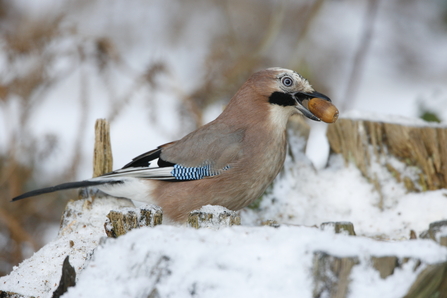While some wildlife curls up to hibernate through winter, there are still a fair few active animals boldly foraging for food.
Unfortunately for some woodland creatures, this winter could be particularly hard. The record-breaking temperatures over the summer months triggered a ‘false autumn’ and put trees under immense stress, causing early fruiting of nuts and berries as they tried to pass their genes on to the next generation.
Jays are the most colourful members of the corvid family, with a chestnut brown body and brilliant blue wing patches. Although they eat invertebrates, beetles, nuts and fruits, they’re particularly famous for their connection with acorns, ‘caching’ them underground as a natural larder.
2020 was what’s known as a ‘mast year’ for oaks, where trees produce a bumper crop so animals and birds can’t possibly eat them all and more acorns germinate. This is particularly taxing so the following year they recover, yet this autumn the trees will be in recovery once again.


